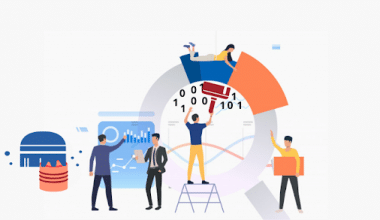Because of big data and analytics service, businesses have transformed tremendously. Most businesses are now aware of how to collect the huge volumes of data that constantly come into their operations and turn it into meaningful insights using analytics. Given its benefits, big data and analytic services are now required for any company looking to maximize its commercial potential.
What is A Data Analytics Service?
Data analytics service is the process of transforming raw data into meaningful insights. It encompasses a variety of tools, technologies, and procedures that use data to identify trends and solve problems. Data analytics has the potential to alter corporate processes, improve decision-making, and drive business success.
What Is Big Data Analytics Service?
Big data refers to massive collections of structured, unstructured, and semi-structured data that are continuously generated at great speed and volume. Typically, big data is measured in terabytes or petabytes. One petabyte is equal to one million gigabytes. To put this into context, consider that a single HD movie comprises approximately 4 terabytes of data. One petabyte is equal to 250,000 films. Large datasets can range in size from hundreds of gigabytes to millions of petabytes.
The process of discovering patterns, trends, and linkages in enormous databases is known as big data analytics. These complicated analyses necessitate specialized tools and technology, as well as computer power and data storage on a large scale.
How Data Analytics Service Can Benefit Your Business
Most businesses are well aware of the benefits of data analytics service. Data is critical, and data analytics can help your company increase output, lower expenses, and improve decision-making. According to a poll, about 90% of participating business users believe that data and analytic services are critical to their organization’s digital transformation goals.
The proper use of big data may benefit businesses of all sizes and industries. Big data and analytic services provide numerous advantages, such as improved decision-making, increased innovation, and optimum product pricing. Let us take a closer look at the key advantages of analytic services:
#1. Customer Retention and Acquisition
Customers’ digital footprints reveal a wealth of information about their preferences, desires, purchasing habits, and so on. Client information can be gathered by businesses from a variety of sources, including social media, traditional retail, and e-commerce. Businesses can learn about consumer behavior in order to provide a more personalized experience by using data analysis services to develop detailed customer profiles from this data.
A company can employ analytic services and big data to observe consumer patterns and then personalize its products and services to the specific demands of each client. This dramatically increases customer pleasure, brand loyalty, and, eventually, income.
#2. Making informed decisions
Businesses can employ data analytics to inform decision-making and reduce losses. Prescriptive analytic services can advise on what to do in response to changes in the business. On the other hand, predictive analytics can advise on how the firm should respond to these changes.
A corporation, for example, can use a model to forecast how changes in pricing or product offers will affect client demand. To assess the viability of the hypotheses generated by such models, it may be essential to modify the items presented. After collecting sales data on the updated items, businesses might use data analytic services and tools to assess the performance of the adjustments and illustrate the results. This will help decision-makers determine whether or not to adopt the changes across the firm.
#3. Promotions that are specific and targeted
Companies can give customized products and services to their target market through data analysis services without spending a fortune on unsuccessful advertising campaigns. Businesses can investigate consumer habits by analyzing point-of-sale transactions and Internet purchases. Using this information, organizations develop focused and targeted marketing strategies to help them meet consumer expectations and encourage brand loyalty.
#4. Make the procedure more efficient.
Organizations can benefit from data analytic services to improve operational effectiveness. Data collection and analysis in the supply chain can disclose the source of production delays or bottlenecks and help predict potential future issues. If a demand forecast suggests that this vendor will be unable to handle the volume required for the Christmas season, an organization could supplement or replace them. This would help to avoid production delays.
Many businesses, particularly those in the retail industry, struggle to maximize their inventory levels. Data analysis services can help organizations determine the appropriate supply for all of their products based on factors such as seasonality, holidays, and secular trends.
#5. Identifying Potential Risks
Organizations operate in high-risk environments, necessitating the use of effective risk management solutions to deal with difficulties. The development of effective risk management procedures and tactics is primarily reliant on big data.
Big data analytic services and technologies swiftly reduce risks by optimizing complex decisions for unforeseen occurrences and potential threats.
Additionally, organizations may use data analytics services to mitigate losses after a setback. If a corporation overestimates demand for a product, data analytics can be used to find the ideal pricing for a clearance sale to eliminate inventory. A company may even construct statistical models that automatically generate answers to chronic problems.
#6. Increase security
Data security threats exist for all businesses. Organizations can use data analysis services to uncover the fundamental causes of earlier data breaches by analyzing and displaying relevant data. For example, the IT division can use data analytics applications to analyze, visualize, and audit logs in order to determine the path and point of origin of an attack. IT can utilize this data to find and address issues. IT departments can utilize statistical models to detect and prevent potential dangers. A load-based assault that typically involves abnormal access behavior is a distributed denial-of-service (DDoS) attack. Organizations can configure these models to run indefinitely, with monitoring and warning systems built on top to detect and highlight discrepancies so that security professionals can respond swiftly.
Top Data Analytics Service Companies
#1. ScienceSoft
ScienceSoft has been designing efficient analytics systems that integrate various data sources into a single point of truth and give reliable insights for data-driven decision-making since 1989.
Manufacturing, healthcare, retail, BFSI, logistics, energy, telecoms, and more than 25 more industries are served by ScienceSoft professionals. They build ETL/ELT pipelines, data lakes, data warehouses, BI tools, AI/ML modules (for predictive analytics and image analysis, for example), and offer modernization, integration, and support services for older analytics systems.
Clients describe ScienceSoft as issue solvers in their testimonials. The team eliminates data silos, automates data management and reporting to reduce human work, improves BI performance, and creates user-friendly dashboards. Some companies report up to 100x faster data analysis and reporting, as well as an 80% improvement in the productivity of their analytics teams.
#2. Innowise Group
With over fifteen years of software development experience, Innowise Group specializes at developing creative software solutions. Their software developers work diligently from their headquarters in Warsaw to produce new solutions that help organizations prosper.
Customers can use their data analytics and management experience to assist manage their data in a way that maximizes its value. They work with each client individually to identify and analyze their needs so that they may make the best selection possible.
#3. Integrate.io
Integrate.io is an information technology and services company that offers a data integration platform. It can connect all of your data sources. It is compatible with online analytical data sources such as AWS Redshift and Google BigQuery.
In addition, it provides marketing, sales, customer service, and development solutions. Integrate.io offers solutions for the retail, hotel, and advertising industries.
Data enrichment, targeted communication, tailored emails, smart segmentation, and other features are available in Integrate.io’s marketing solution. Its customer support solution can assist you in determining which business methods require modification. Its sales solution will include powerful analytics.
#4. Indium Software
Indium Software is a technological solutions provider with a strong background in data analytics and data engineering. Its presence in the industry for more than 20 years places it among the top 15 Big data consulting firms, according to Clutch.
Indium’s data solutions are strong and cutting-edge, with project governance available 24 hours a day, seven days a week. It provides a comprehensive set of data analytics services to businesses in order to optimize the value of their real-time, historical, or external data.
#5. InData Labs
InData Labs is a major provider of AI and Big Data solutions. It creates AI-powered solutions to address modern big data business concerns, assisting clients in extracting actionable insights from real-time data and applying them to effective digital transformation.
InData Labs develops unique software for companies of all sizes and from a variety of industries, including logistics, healthcare, sports and wellness, e-commerce, manufacturing, marketing, gaming, and entertainment.
The objective of InData Labs is to assist its clients in implementing AI to scale up their businesses and simplify operational operations.
#6. Oxagile
Oxagile is a full-service software development firm specializing in traditional and sophisticated data analytics for media, entertainment, advertising, e-commerce, retail, and other businesses and domains.
Data analysis and visualization, custom reporting and dashboarding, cutting-edge BI tool implementation, BI system optimization, complete ML analytics, and other services are among the company’s specialties.
Oxagile handles a variety of business difficulties with this knowledge, including customer hyper-segmentation, data-driven recommendation and subscription packages, and marketing campaign modification. Oxagile’s technology stack includes AWS and Google data services, as well as reputable BI solutions like as Tableau, Qlik, Looker, Microsoft Power BI, and others.
#7. Vention
Vention is a custom software development firm that assists startups and organizations with streamlining and future-proofing their analytics processes. Vention’s specialist teams create user-centric and tailored solutions, enabling clients to use the value of insights gleaned from billions of interactions.
#8. SG Analytics
A global insights and analytics firm headquartered in Pune, SG Analytics was founded in 2007 and is a leading provider of data-centric research, contextual analytics, and ESG services to Fortune 500 companies in the BFSI, Technology, Media & Entertainment, and Healthcare sectors.
SG Analytics is a GDPR and ISO/IEC 27001: 2013 compliant company with over 1100 people and offices in the United States, the United Kingdom, Switzerland, Canada, and India.
The company received the “Regional Best Employer” award in 2016 and 2017, and it maintained its reputation in 2018. AIMs 2022 Report recognized the organization as a key participant among Data Science Providers in India.
Google Analytics Service
Google Analytics is a tool that collects data from your websites and apps in order to provide reports that provide business insights.
How Does The Google Analytics Service Work?
#1. Website evaluation
To measure a website, you must first set up a Google Analytics account. Then, on each page of your website, put a short bit of JavaScript measurement code. When a person views a webpage, the tracking code collects pseudonymous data about how that user interacts with the page.
For the Google Store, the measuring code may display how many customers visited a drinkware page versus a houseware page. It may also tell us how many users purchased an item, such as an Android doll, by tracking whether they reached the purchase confirmation page.
The measurement code will also collect information from the browser such as the language setting, browser type (such as Chrome or Safari), device, and operating system on which the browser is running. It may also track the “traffic source,” or what drew users to the site in the first place. This might be a search engine, an advertisement, or an email marketing campaign.
#2. Reporting and processing
When the measurement code collects data, it packages it and transmits it to Google Analytics, where it is processed into reports. Analytics aggregates and organizes data based on specific criteria such as whether a user’s device is mobile or desktop, or which browser they’re using.
However, there are configuration options that allow you to tailor how that data is processed. For example, you may use a filter to ensure that your data does not include any internal corporate traffic or developer activity.
After Analytics processes the data, it is saved in a database and cannot be modified.
So, when configuring your settings, don’t exclude any data that you believe you might wish to study later. Once the data has been processed and stored in the database, it will display as reports in Google Analytics.
What is Business Analytics Service?
Business analytics is a term that refers to the administration of an organization’s data, with a focus on statistical analysis. It entails the use of modern technology and procedures to analyze data from a wide range of sources and in enormous quantities.
Benefits of Business Analytics for a Company
- Present information in a logical and ordered manner.
- Examine the company’s data.
- Use appropriate indicators to aid decision making.
- Consolidate all data, including purchases, sales, accounting, and customers.
- Use the same indications for the entire firm to automate the decision-making process.
- Increase the visibility of numbers, discrepancies, and anomalies.
- Forecast trends and anticipate business challenges.
As you can see, the advantages of data analytics for a business are numerous, and they constitute an essential source of information on which to base strategic decisions and confidently forecast the future.
Business Analysts can use good data visualization to translate enormous data sets and metrics into charts, graphs, and other features that make data easier to depict and understand, as well as share real-time insights, trends, and outliers.
What Is The Scope Of Business Analytics?
Here are some of the fundamental steps of a strong Business Analytics plan.
#1. Investigate and identify business requirements
The first step in the business analytics process is to understand what the company wants to improve or what problem it wants to solve.
The stakeholders, users with process knowledge, and the analyst(s) decide on the relevant data to solve these objectives.
Key concerns such as “what is the available data,” “how can we use it,” and “do we have enough data” must be addressed during this phase.
#2. Mining of Macrodata
This stage involves cleaning up the data and doing calculations for lost data, removing outliers, and changing variable combinations to generate entirely new variables.
A specialized tool can already be used in this situation.
Time series graphs are created to display normal or dissimilar values.
The elimination of divergent values from the dataset is a critical task in this step, because different values frequently influence the accuracy of the model if they are allowed to stay in the dataset.
The analyst will gain a better understanding of the data if it is clean. He or she will use scatter diagrams to trace the data in order to find any interrelationships or misalignments. He or she will visually examine all potential data ranges and synthesis the data using appropriate visualization and descriptive statistics to help stakeholders obtain a basic understanding.
#3. Analytics of Data
The analyst will find all aspects connected with a target dynamic using statistical analysis approaches such as correlation analysis and hypothesis testing.
He or she will also perform a simple regression analysis to see whether simple predictions can be made.
Furthermore, alternative groupings are contrasted with different scenarios, which are then examined via hypothesis testing.
#4. Forecast what is likely to occur.
Predictive analytics is used in business analysis to be proactive in decision-making. The analyst uses prediction techniques like as decision trees, neural networks, and logistic regression to moderate data.
These strategies provide new ideas and models, revealing linkages and “hidden evidence” of the most influential variables. The analyst then compares the predicted values to the actual values, calculating the predictive errors.
Multiple prediction models are typically run, and the best-scoring model is chosen based on precision and performance.
#5. Look for the best answer.
The analyst will execute hypothetical scenarios using the prediction model’s coefficients and outcomes. The analyst will use manager-defined objectives to discover the optimal solution, taking into account restrictions and limitations.
The ideal solution and model will be chosen by the analyst based on the least amount of mistakes, business objects, and intuitive awareness of the model coefficients that are most aligned with the organization’s strategic goal.
#6. Decision-Making and Outcome Evaluation
The analyst will make decisions based on model findings and corporate objectives.
After a predetermined period of time, the action will be measured.
#7. Update the system with the decision’s outcome.
Finally, the model’s decision and action outputs, as well as new learnings, are saved in the database.
There is information supplied such as “Did the decision and action work?”, “How did the treatment group compare to the control group?” and “What was the ROI?” As a result, an ever-changing database is created that is constantly updated with new insights and knowledge.
How Does Analytics Work?
Analytics aggregates and organizes data based on specific criteria such as whether a user’s device is mobile or desktop, or which browser they’re using. However, there are configuration options that allow you to tailor how that data is processed.
What Is Analytics On My Phone?
Phone Analytics allows you to track the effectiveness of phone conversations as part of the conversion funnel. To use Phone Analytics, configure your Analytics property and add a snippet to your Analytics tracking code on any page where your phone number appears.
Conclusion
Data analysis services can help a firm with everything from personalizing a marketing message to a specific client to identifying and mitigating business risks.
Related Articles
- DATA ANALYST TOOLS: 13+ Best Data Analyst Tools 2023
- DATA MANAGEMENT PLATFORM: What Is DMP & Best Platforms
- DATA ANALYSIS COMPANIES: Top Data Analytics Companies of 2023
- What Is a Big Data Engineer, and How Do You Become One?






